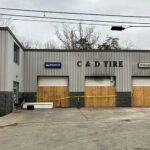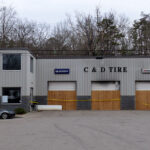No criminal charges will be filed against three Oak Ridge Police Department officers after a fatal shooting on Briar Road in August, the county’s top prosecutor said Monday.
Seventh Judicial District Attorney General Dave Clark released his report about the police shooting on Monday morning.
The report said that the man who died in the shooting, Fred J. Arcera, 25, was a U.S. Army veteran who had mental health problems and was reported to be suicidal—telling officers to kill him—and he had large butcher knives and had threatened officers, moving toward them with the knives that Saturday night.
The Tennessee Bureau of Investigation investigated the shooting, which is common after law enforcement officers fatally shoot someone.
Clark’s report is below. See Arcera’s obituary here.
***
MEMORANDUM
TO: File
FROM: Dave Clark
DATE: February 6, 2021
RE: Officer Involved Fatal Shooting of Fred J. Arcera
INTRODUCTION
On August 15, 2020 I received a telephone call from Oak Ridge Police Department (ORPD) command staff advising there had been an officer involved shooting at 115 Briar Road in Oak Ridge. Information suggested the shooting was fatal or likely to be fatal. In consultation with ORPD command staff and consistent with prior and best practice standards, I contacted the Tennessee Bureau of Investigation (T.B.I.) to conduct the investigation in the interest of a thorough and independent investigation and to assure public confidence in whatever investigative findings might result.
I proceeded to the scene where ORPD was initially assisted by others from the District Attorney’s Office, the Oak Ridge Fire Department, the Anderson County Ambulance Service and the Medical Examiner’s Office. The T.B.I. arrived on scene and assumed command of the investigation.
The T.B.I. has concluded its investigation and provided me access to their investigative materials, reports, evidence and the like. The T.B.I. collected initial evidence and information from those persons or agencies on the scene before T.B.I. arrived. All of those materials are incorporated into the T.B.I. investigation. I have monitored the investigation along the way, discussed questions and concerns with the T.B.I. Agents and reviewed the materials from the T.B.I. and other sources. What follows are my findings and conclusions from all of the information made available to me.
INVESTIGATIVE FACTS
On Saturday August 15, 2020, at approximately 9:30 P.M., Anthony Arcera dialed 911 and reported to a dispatcher that his son, Fred J. Arcera (DOB: 1/16/1995; hereinafter, “Subject†or “Fred Arceraâ€) was armed with a knife or knives and attempting to commit suicide at 115 Briar Road in Oak Ridge. It was also reported to 911 that Subject had lunged at Anthony Arcera with a knife.
The investigation revealed that Fred Arcera was a military veteran who had suffered mental health problems. Fred Arcera had recently been a mental patient at a Veteran’s Administration facility and had been released from in-patient care the prior Wednesday. Anthony Arcera concluded that his son had been released from the facility too soon and was worried about his mental condition. Anthony Arcera traveled from his home in North Carolina to be with his son at his son’s residence in Oak Ridge.
Anthony Arcera noted that Subject Arcera’s condition had been worse Saturday, August 15th than he had ever observed previously. His son was taking walks during the day and reporting to his father that there were written messages on the streets during his walks that were communicating to him.
Shortly before dialing 911, Anthony Arcera reported that Subject Arcera came out of his bedroom and told his father that, “he could not do it anymoreâ€. Anthony Arcera noticed that Fred had blood on his shirt and Fred showed Anthony Arcera that there were cuts on his wrists. Fred then swallowed pills from two prescription bottles. Anthony attempted to provide medical aid to his son, but Fred Arcera picked up large butcher knives in the kitchen and lunged at him with the knives. Ultimately, Fred Arcera sat down in the home while continuing to hold the butcher knives. That is when Anthony Arcera dialled 911.
He reported to 911 that his son, Fred Arcera had cut himself in a suicide attempt, was armed with knives and had lunged at him. Anthony Arcera stayed on the line with the 911 dispatcher. In response to the call, Oak Ridge Police, Oak Ridge Fire Department (ORFD)(as medical first responders) and Anderson County EMS (ACEMS) were dispatched to the residence. ORFD and ORPD arrived first. ORFD stopped or staged their trucks 2-3 houses down the street until the scene could be made safe by ORPD. Three ORPD officers arrived at approximately the same time. They were: Jeremy Phillips, Joseph Gibson and Corey Fritz. All three officers were in conspicuously marked vehicles and traditional police uniforms. When they arrived on seen, Anthony Arcera was waiting for them on the front porch.
Jeremy Phillips approached the front porch while Officer Fritz retrieved a first aid kit from a cruiser. Officer Gibson also approached the front porch but was behind Officer Phillips. Anthony Arcera and Officer Phillips entered the home through the front door. Officer Phillips observed a bleeding Fred Arcera sitting in a chair with a large butcher knife in each hand. His initial responsibility was to render the scene safe so that medical care could be provided to Fred Arcera. Officer Phillips ordered Subject Arcera to drop the knives. Instead, subject Arcera stood from the chair, raised the knives and stepped toward Phillips while yelling, “Just f***ing kill me.†As Subject Arcera approached, Officer Phillips fired two shots while retreating back out of the front door to the front porch and down a short stairwell to the front yard. As Phillips was retreating, Officer Gibson had arrived on the front porch and opened a screen door for the retreating Phillips. Gibson also retreated to the front yard.
Upon hearing shots fired, Officer Fritz also joined Phillips and Gibson and all took up positions in the front yard near the bottom of the stairs to the front porch. At some point as these events were unfolding, another ORPD officer, Larry Dowdell arrived at the scene and witnessed the events.
Inside the home, Subject Arcera fell to the floor after Phillips fired two shots. He stood back up and told Anthony Arcera, “they are just firing blanks.†Subject Arcera went to the storm door at the front entrance to the house looking out at officers while holding the two butcher knives. He appeared to strike at the front door with the knives and was saying something unintelligible. It appeared to at least one of the officers that there was a bullet hole in Subject Arcera’s shirt. Officers repeatedly yelled to Subject Arcera to drop the knives.
After his brief pause at the screen door, Subject Arcera pushed open the screen door and stepped quickly onto and across the porch as he raised the butcher knives above his head while yelling, “f***ing kill me.†All three officers positioned at the base of the front porch stairs fired their handguns. Arcera was continuing across the porch and down the stairs toward the officers as they fired. Fred Arcera appeared to have been struck by gunfire and fell to the ground landing with his head on the ground and his feet still on the stairwell from the porch.
Officers attempted to render first aid and called for ORFD to assist. Nevertheless Fred Arcera was deceased.
A crime scene was immediately marked off and the District Attorney was contacted and in turn the T.B.I. was requested. The Medical Examiner’s Office was also notified to dispatch an investigator to the scene. The three officers who fired were separated at the scene and were then relieved of their duty weapons and their spare magazines which were entered into evidence. The officers were all photographed and taken to Methodist Medical Center for drug testing.
The sirens of the first police and fire department vehicles caused neighbors to emerge from their homes; some of whom witnessed a portion of the events. Some firefighters witnessed events unfold from the cabs of their fire trucks 2-3 doors down the street. ORPD Officer Dowdell arrived at the scene too late to reach the front porch or to fire his weapon, but he witnessed the events outside the home. Officer Dowdell’s in-car camera captured some of the events and the open phone line with 911 dispatch recorded some of the audio of the events. All of these sources of witness account, video recording or audio recording are consistent with the reports of Anthony Arcera as well as Officers Jeremy Phillips, Corey Fritz and Joseph Gibson.
The body of Fred Arcera was transported from the scene to the Regional Forensics Center for an autopsy. The autopsy revealed that Subject Arcera died from multiple gunshot wounds. There were a total of ten gunshot wounds, all travelling from the front to rear of the body. Toxicology revealed the presence of alcohol and alcohol metabolites, THC (marijuana) and THC metabolites, caffeine, nicotine metabolites, trazadone (sedative), gabapentin (antiepileptic/anticonvulsant) as well as risperidone (anti-psychotic) and risperidone metabolites.
The T.B.I. investigation notably revealed that Subject Arcera’s bedroom contained a plastic bucket containing blood and a knife. The bed linens also contained a substantial quantity of blood. There were blood droplets from Fred Arcera’s bedroom to the living room where Subject Arcera made contact with his father, Anthony Arcera, and sat in a chair holding the butcher knives. There was a concentration of blood adjacent to the chair where Fred Arcera had been sitting. There was suspected marijuana and prescription medications found in Subject Arcera’s bedroom that were all consistent with the autopsy toxicology results.
The officers were all interviewed and their statements were consistent with one another as well as being consistent with independent witness statements, the crime scene evidence and recordings. The Officers’ drug test results were all negative. The Officers were completely cooperative during the investigation. Examination of their firearms and magazines were also relatively consistent with the Officer statements. There were a total of 13 rounds fired based on a comparison between the capacity of the department issued weapons and the remaining rounds found in the firearms. Officer Phillips fired six times, Officer Gibson fired four rounds times and Officer Fritz three times. Officer Fritz thought he fired twice, but it appears he actually fired three times. Officer Phillips thought he fired four to six rounds and the evidence indicates he fired six times.
The officers were found to have been properly certified. None of them had any prior contact with, knowledge of or any detected reason to have animus toward Fred Arcera.
Some police departments have training to assist officers in dealing with individuals living with mental illness. This is commonly referred to as Crisis Intervention Team or CIT training and certification. ORPD has such a program and all three of the officers who fired in this instance had received training and certification in CIT. None of the officers who fired had a history of use of force policy violations noted in their personnel files.
FINDINGS AND CONCLUSION
The Oak Ridge Police Department immediately preserved a scene at the time of this officer involved shooting. They contacted the District Attorney General and I in turn contacted the T.B.I. in order to preserve evidence and complete an investigation into the shooting that resulted in the death of Fred Arcera. This effort may have had multiple ultimate purposes, but the point of the inquiry by the T.B.I. and the District Attorney General is principally to determine whether a crime occurred.
There is no question as to a number of factors. It is clear that Fred Arcera is deceased and that he died as a result of multiple gunshots. It is clear that three Oak Ridge Police officers shot him. The question for determination is whether the officers committed a crime when they shot and killed Subject Arcera.
Police Officers are individuals that we trust and invest with special legal authority, including the authority to use force. That force may include lethal force under limited circumstances. They receive special training and licensure in Tennessee as to their police powers and the use of force. Each police agency also adopts guidelines with regard to their officers’ use of force. Those agency specific guidelines may vary, but must fall within broader legal guidelines established by legislative laws and court authority.
In this instance, the Oak Ridge Police Department had adopted use of force guidelines. These guidelines fall within the legal requirements for agency specific use of force policies. Officers are encouraged to use the minimal force necessary and to attempt to de-escalate confrontations if the tactical circumstances permit. Specifically, in regard to the use of deadly force, Oak Ridge Police Department policy provides, “[a]n officer is justified in using deadly physical force only when he or she reasonably believes such force is necessary to:
- Defend the officer, or a third person, from imminent threat of death or serious bodily injury.†(General Order 402; IV. Procedures; D. Use of Deadly Force in Defense of Human Life)
While the authorization of deadly force procedure goes on to cover other circumstances, part one is what is pertinent for this investigation.
So, the issue is, could another police officer in similar circumstances reasonably believe that the use of a firearm was necessary to defend himself or herself or another person or officer from imminent threat of death or serious bodily injury? In this instance, the use of deadly force should be evaluated as two related incidents. First, Officer Phillips used lethal force inside the home when he fired two shots at Subject Arcera. Secondly, Officer Phillips, Fritz and Gibson used lethal force again moments later by discharging their firearms as Subject Ascera exited the home onto the front porch and stairs.
In the first instance, there is no doubt that Subject Arcera was armed with two large knives when Officer Phillips entered the home. It was reported to officers as the result of the 911 call that Subject Arcera had lunged at Anthony Arcera with the knives before officers arrived. He had thus exhibited a willingness to at least display deadly weapons as if he had an intent to do harm. It further appears that Officer Phillips entered the home as a uniformed officer and gave commands to Subject Arcera to drop the knives but that Subject Ascera failed to comply. A uniform officer’s presence and verbal commands are both recognized as efforts to assert control short of the use of force. However, Subject Arcera’s actions prevented other techniques from being practical as he stood from his chair in close proximity to Officer Phillips, held the knives in a manner consistent with an intent to attack, screamed, “just f***ing kill me†and lunged at Officer Phillips.
There could be no reasonable dispute that Subject Arcera represented an imminent threat of death or serious bodily injury to Officer Phillips under these circumstances. The weapons Subject Arcera had and his proximity to Phillips did not safely allow Phillips any other option but to either discharge his firearm or be stabbed. Phillips’ two shots temporarily neutralized the threat from Arcera and allowed Phillips to retreat; which he did successfully. Officer Jeremy Phillips was legally justified in his use of lethal force against Fred Arcera when he fired twice inside the home.
We do not know whether or where Subject Ascera was struck by bullets fired by Officer Phillips inside the home. Based on the number of bullet wounds (10) and shots fired (13), it is possible that Phillips did not strike Subject Arcera with either of those two shots. However, Arcera did go to the ground after Phillips fired and Phillips was able to retreat. In addition, there was at least one observation that it looked like Subject Arcera had a bullet hole in his shirt immediately after Phillips exited the home. This is contraindicated by Subject Arcera’s statement to his father, Anthony Arcera, that he thought police were firing blanks. On balance, it seems most likely that Phillips’ rounds struck Subject Arcera at least once and that his comment was either the result of his not realizing he had been shot or bravado.
In any event, that takes us to the second incident moments later when lethal force was used by Officers Phillips, Fritz and Gibson. The circumstances were much the same, except that at that later time officers also knew that even the display, discharge and possible wounding with a firearm in addition to the earlier factors had not persuaded Subject Arcera to drop his weapons.
As Fred Arcera stood at the storm door to his home brandishing his knives and stabbing at the door itself, the officers outside continued to order him to put down the knives. Arcera again failed to comply. Once again, officers did not initiate the escalation that followed, but Arcera chose to exit the home, display the knives in a threatening manner and move toward the officers who were still in close proximity. As he did so, Subject Arcera once again yelled something along the lines of, “kill me motherf***ers!†All three officers were in the zone of danger presented by an advancing subject armed with a knife or knives. All three officers were within their legal right to defend themselves or one another. All three officers discharged their firearms. Phillips fired four rounds, Gibson fired four rounds and Fritz fired three rounds.
In these instances there are always questions about whether other less lethal means existed for officers to reasonably defend themselves or other third parties. These are reasonable questions to ask. Indeed, I have considered it as part of this investigation. It is possible that Subject Arcera would have been deterred by the use of a chemical spray agent, or a taser. It is also possible that Officer Phillips in the first instance or Officer Phillips, Fritz or Gibson in the second instance could have successfully disarmed and subdued Arcera using an ASP contact weapon or even bare handed techniques. While any of those things are possible, none are likely to have been successful or at least were not reasonably sure to be effective such that we would require the officers to risk serious bodily injury or death had the technique not worked and Subject Arcera had successfully stabbed one or more of them with the large bladed knives. Had Arcera given officers time or the circumstances, some other less lethal techniques may have been appropriate, but in this case, Arcera dictated the time, place and manner of the confrontation.
The next frequent question that arises in officer involved fatal shootings is why the officers did not shoot the weapon from the hand of the subject or perhaps shoot the subject in the leg or arm to wound them rather than shots that are directed to strike vital areas. First, accuracy of the sort required to reliably shoot a weapon from a subject’s hand is the stuff of Hollywood movies or special circumstances with special personnel and weaponry. Officers in the field with handguns, adrenaline rushing and split seconds to act cannot reliably make such shots. They are not trained to do so. The same would be true of shooting at appendages. Officers are taught to fire at the center mass of the body until the threat that caused the need for lethal force has ended; whether that be surrender, disarmament, flight or incapacitation.
This investigation does not reveal circumstances that could reasonably provide grounds for a criminal charge against any of the three officers involved. The investigation and file will be closed.
It is gratefully acknowledged that the Oak Ridge Police Department, Oak Ridge Fire Department, Anderson County Emergency Management Services, The Regional Forensics Center and numerous witnesses have provided cooperation in this investigation. As always, I am particularly grateful for the immediate and robust response of the T.B.I. and the thorough and expert investigation that followed.
EPILOGUE
Having completed the principal purpose of the investigation and this memorandum, I cannot help but record my sense of tragedy that these circumstances represent as well as a sense of frustration. Fred Arcera was a military veteran who had deployed to a war zone on behalf of our country and had been injured. While it isn’t clear whether the injury was in combat, otherwise in the line of duty or through some other means, he was apparently a disabled veteran. He was receiving mental health care from the Veteran’s Administration, but, at least in hindsight, it is obvious that his mental health issues were not under control shortly after he was released from in-patient care.
As prosecutors, we are in the business of doing justice and holding those who violate our laws personally responsible through the criminal justice system. That said, too often, we see in this community and others across our state and country that crime often occurs as a result of drug addiction, mental illness or a combination of the two. Drug addiction can lead to mental health problems and mental health problems can lead to drug addiction. Drug treatment resources are in short supply and mental health services are also rationed due to the meager supply of services and the great need for them. It is acknowledged that it must be difficult for our leaders to make decisions about how to allocate scarce public resources.
Anthony Arcera knew his son was in trouble. He believed he had been released from in-patient care too soon and traveled to Oak Ridge to be with him and ultimately take him back to his residence in North Carolina. It is hard to imagine how he could have done more for his son. While Officers Phillips, Gibson and Fritz fired the fatal shots, it was Fred Arcera’s mental health problems that killed him. His pain obviously caused him to seek death; judged not only by his obvious actions but also his words. He told his father he wanted to die and before his own efforts that day were successful in ending his own life, he demanded and ultimately succeeded in forcing the police to shoot him.
One cannot help but wonder if Fred Arcera had received different care or placement whether he would be alive today and all involved would have been spared the grief and hardship that was caused.




Leave a Reply